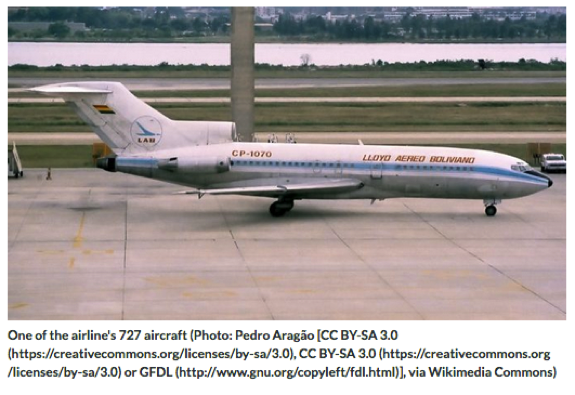
TBT (Throwback Thursday) in Aviation History: Lloyd Aéreo Boliviano
October 19, 2017 - airline.geeks.com
One of the airline's 727 aircraft (Photo: Pedro Aragão [CC BY-SA 3.0 (https://creativecommons.org/licenses/by-sa/3.0), CC BY-SA 3.0 (https://creativecommons.org/licenses/by-sa/3.0) or GFDL (http://www.gnu.org/copyleft/fdl.html)], via Wikimedia Commons)
In the 1920s with the expansion of the commercial aviation industry, more and more airlines began to arise. The South American country of Bolivia saw its first commercial carrier start service in 1925. The new carrier, Lloyd Aéreo Boliviano (LAB), was formed by Guillermo Kyllmann with the goal of servicing the domestic market. The carrier was gifted a Junkers F.13 to start operations and began flying on September 23, 1925.
By the 1940s, LAB had become the leading airline in the Bolivian aviation market, with the government wanting to make it the official flag carrier for the nation. The government took control of the airline and expanded service to neighboring countries, while also expanding the fleet to include the larger Lockheed L-188.
The airline continued to expand into the 1950s and 1960s, with the carrier starting and increasing service to Argentina, Brazil, Chile, Panama, Paraguay and Peru. LAB added a number of Douglas aircraft to their fleet, including Douglas DC-3 in 1945, the DC-4 in 1955 and the DC-6 in 1960.
The carrier landed their first jet aircraft in 1970, with the arrival of the Boeing 727. The trijet would service the popular domestic routes. The airline would later use the jet to fly into North America, launching service to Miami, Havana and Washington D.C. in the years following.
LAB was able to stabilize their expansion through the 1980s, but the 1990s proved to be a challenge. Rising fuel prices took their toll on the Boeing 727 fleet, while the airline was also trying to bring in bigger jets like the Boeing 767 and Airbus A300 into the fleet.
The airline was also now competing with privatized carrier AeroSur, which launched operations in 1992. With LAB suffering, the Bolivian government opted to sell the airline to Brazilian carrier Viação Aérea São Paulo (VASP) in 1994.
The sale, however, did not turn out to be a permanent move. VASP, rapidly collapsing in the late 1990s, was forced to sell the airline back to the Bolivian government. The government repurchased the airline from VASP in 2001.
Back under control of the Bolivian government, LAB attempted to reduce its costs. The airline returned leased widebody aircraft that the company could no longer afford, as well as retired older airframes. The airline also bought shares of Ecuatoriana de Aviación, Equador's national airline, and formed a codeshare agreement between the two carriers, unlocking more northern South America destinations, such as Caracas, Venezuela.
Despite the cost-cutting, pressure from AeroSur and a weak economy forced the Bolivian government to close Lloyd Aéreo Boliviano. The carrier's last day of scheduled operations was March 30, 2007, with the government also announcing a new flag carrier, Boliviana de Aviación, starting operations in October of the same year.
Boliviana de Aviación would not inherit any of the LAB fleet, instead, starting fresh with a fleet of Boeing 737-300s and Boeing 767-300ERs. Boliviana de Aviación is now the sole carrier of Bolivia, after AeroSur filed for bankruptcy in 2012.